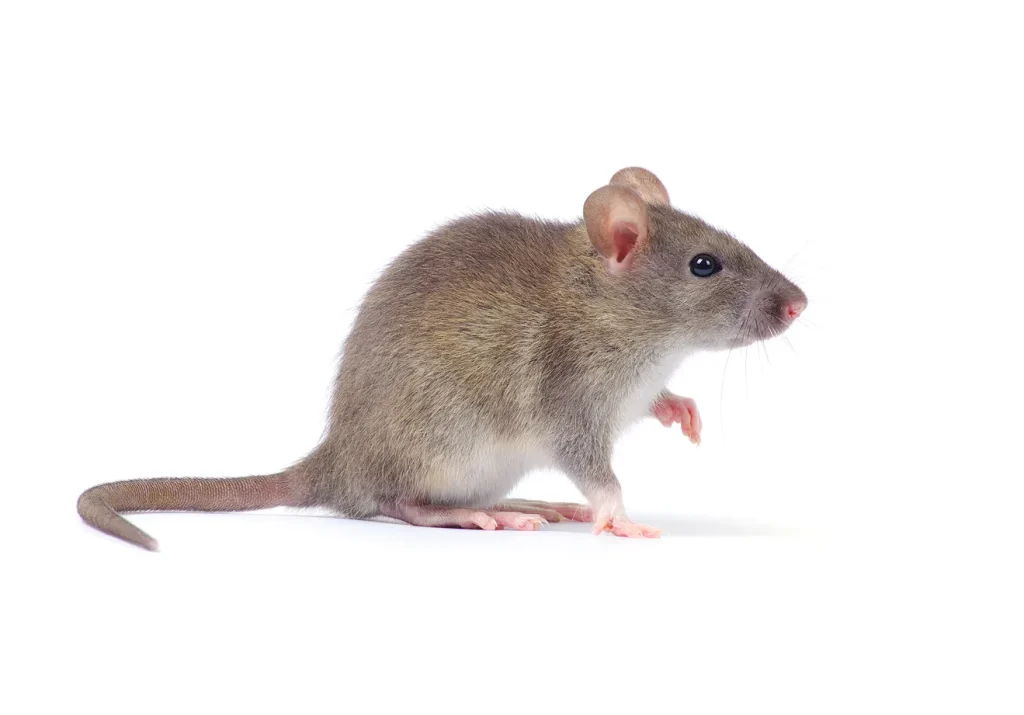
RODENT
Common types: House rat, mouse, Roof Rat
Size: 16 to 20 cm (body length)
Life Span: 9 to 12 months
Rats thrive in environments where food, water, and shelter are easily accessible. They are commonly found in urban and suburban areas, nesting in attics, basements, ceilings, and wall voids. Unlike their burrowing relatives, roof rats prefer elevated spaces and use their sharp claws and long tails for balance while climbing. They are highly adaptable and can squeeze through gaps as small as a quarter of an inch. Outdoors, they take shelter in overgrown vegetation, palm trees, and abandoned buildings. Their nocturnal nature makes them difficult to spot during the day, but their presence can be detected through gnaw marks, droppings, and grease trails left along frequently travelled paths.
Roof rats are also known for their destructive chewing habits, which can damage electrical wiring, wooden structures, and plastic containers. Their incisors grow continuously, so they gnaw on various materials to keep them trimmed. They are social animals and tend to live in colonies, making infestations spread quickly. Their diet consists of fruits, seeds, nuts, grains, and garbage, though they are opportunistic feeders and will consume nearly anything available. Since they breed rapidly, a small rat problem can quickly turn into a severe infestation if left uncontrolled.
As pest
Rats pose serious health risks due to their ability to spread diseases through bites, droppings, urine, and fur. They are known carriers of pathogens that cause illnesses such as Leptospirosis, Hantavirus, Salmonellosis, and Rat-Bite Fever. Contaminated food and water sources can lead to outbreaks of food poisoning and other bacterial infections. Their urine and dander can also trigger allergic reactions and worsen respiratory conditions like asthma.
In addition to health concerns, rats cause extensive property damage by chewing through insulation, drywall, pipes, and even soft metals. Their tendency to gnaw on electrical wires increases the risk of short circuits and fire hazards. Businesses in the food industry face reputational and financial losses due to failed health inspections resulting from rodent infestations. Signs of rat activity include droppings near food storage areas, gnawed packaging, shredded nesting materials, and scratching or squeaking sounds at night. Strong, musky odours are another indication of their presence, particularly in enclosed spaces. The longer an infestation is left unaddressed, the harder it becomes to control, as rats reproduce rapidly and quickly establish colonies in hidden areas. Their adaptability makes them one of the most persistent and difficult pests to eliminate.

How to control
Preventing rat infestations starts with eliminating potential entry points and reducing access to food and shelter. Sealing cracks, holes, and gaps with durable materials like steel wool, metal sheeting, or cement helps prevent them from sneaking into buildings. Proper sanitation is key—garbage bins should have tight-fitting lids, food should be stored in sealed containers, and spills should be cleaned up immediately. Overgrown vegetation and clutter provide ideal hiding spots, so keeping yards and storage areas tidy reduces their ability to nest. Snap traps, electronic traps, and bait stations are commonly used for control, but placement is crucial to ensure effectiveness. Glue traps can capture rats, but they are less humane and can be ineffective against larger infestations.
Natural deterrents like peppermint oil and ammonia may discourage rats temporarily but do not provide a long-term solution. Since rats are cautious and can develop resistance to certain poisons, professional pest control is often necessary for large infestations. Experts use a combination of methods, including exclusion, baiting, and tracking techniques, to ensure thorough eradication. Routine monitoring and preventive measures are essential to stop new infestations from occurring.

